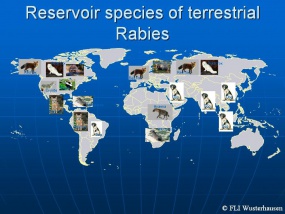Classification

Rabies is caused by negative strand RNA-viruses belonging to the genus Lyssavirus, family Rhabdoviridae of the order Mononegavirales. According to the International Committee on Taxonomy of Viruses (ICTV) the genus Lyssavirus is delineated into different virus species based on demarcation criteria such as genetic distance and antigenic patterns in reactions with panels of antinucleocapsid monoclonal antibodies. This demarcation is further supported by geographic distribution and host range (see table).
Lyssavirus species segregate into two phylogroups. Phylogroup 1 includes Rabies virus (RABV), Duvenhage virus (DUVV), European bat lyssaviruses, type 1 and 2 (EBLV-1 and 2, respectively), and Australian bat lyssavirus (ABLV). Also, Aravan virus (ARAV), Khujand virus (KHUV), and Irkut virus (IRKV) cross-react serologically with members of phylogroup 1. Phylogroup 2 includes Lagos bat virus (LBV), Mokola virus (MOKV), and Shimoni bat virus (SHIBV). There is a significant serological neutralization within phylogroups, but very limited crossneutralization has been detected between phylogroups.
West Caucasian bat virus (WCBV), Ikoma lyssavirus (IKOV) and Lleida bat lyssavirus (LLBV) may form independent phylogroups.
Rabies virus (RABV), the prototype lyssavirus, is the causative agent of the classical rabies and is responsible for the vast majority of all human rabies cases. However, it can be assumed that all lyssaviruses can cause indistinguishable fatal encephalitis both in humans and other mammals.
Interestingly, bats are primary or sole reservoir hosts for all lyssaviruses except MOKV (for which the reservoir species has not been clearly identified as of yet).
a ICTV = International Committee on Taxonomy of Viruses (www.ictvonline.org/)
#Arechiga Ceballos et. al., 2012; so far, only viral genomic material was identified which is not sufficient for declaration of a novel species